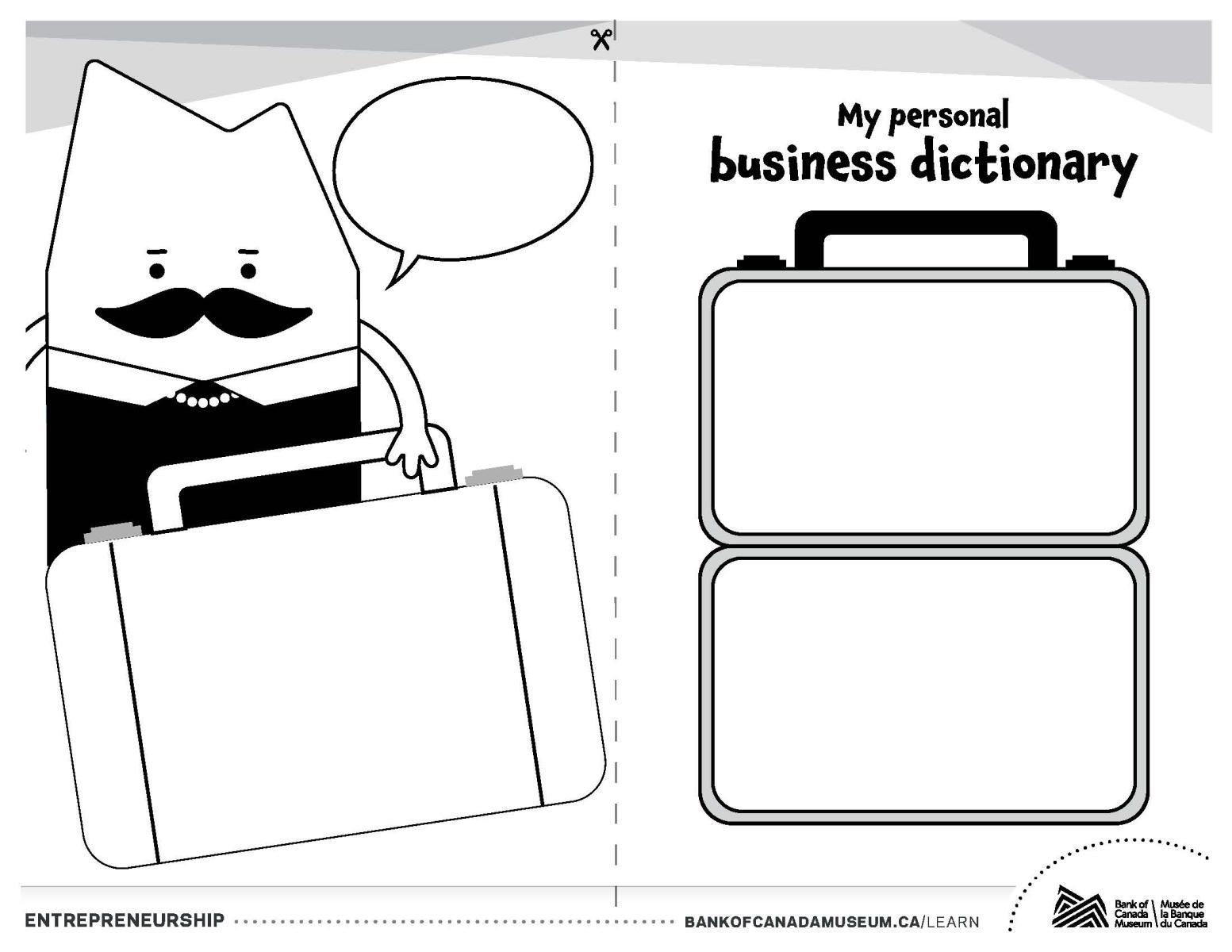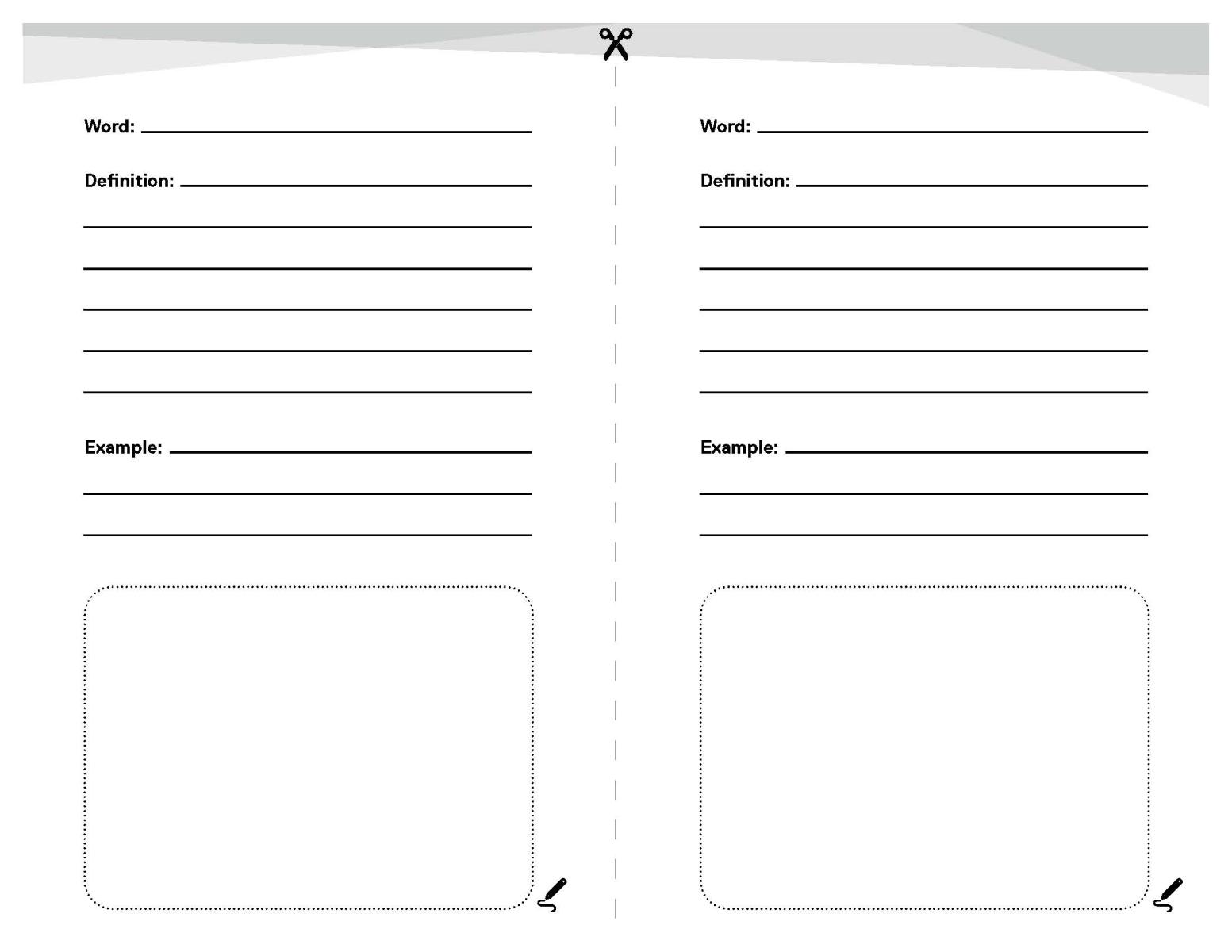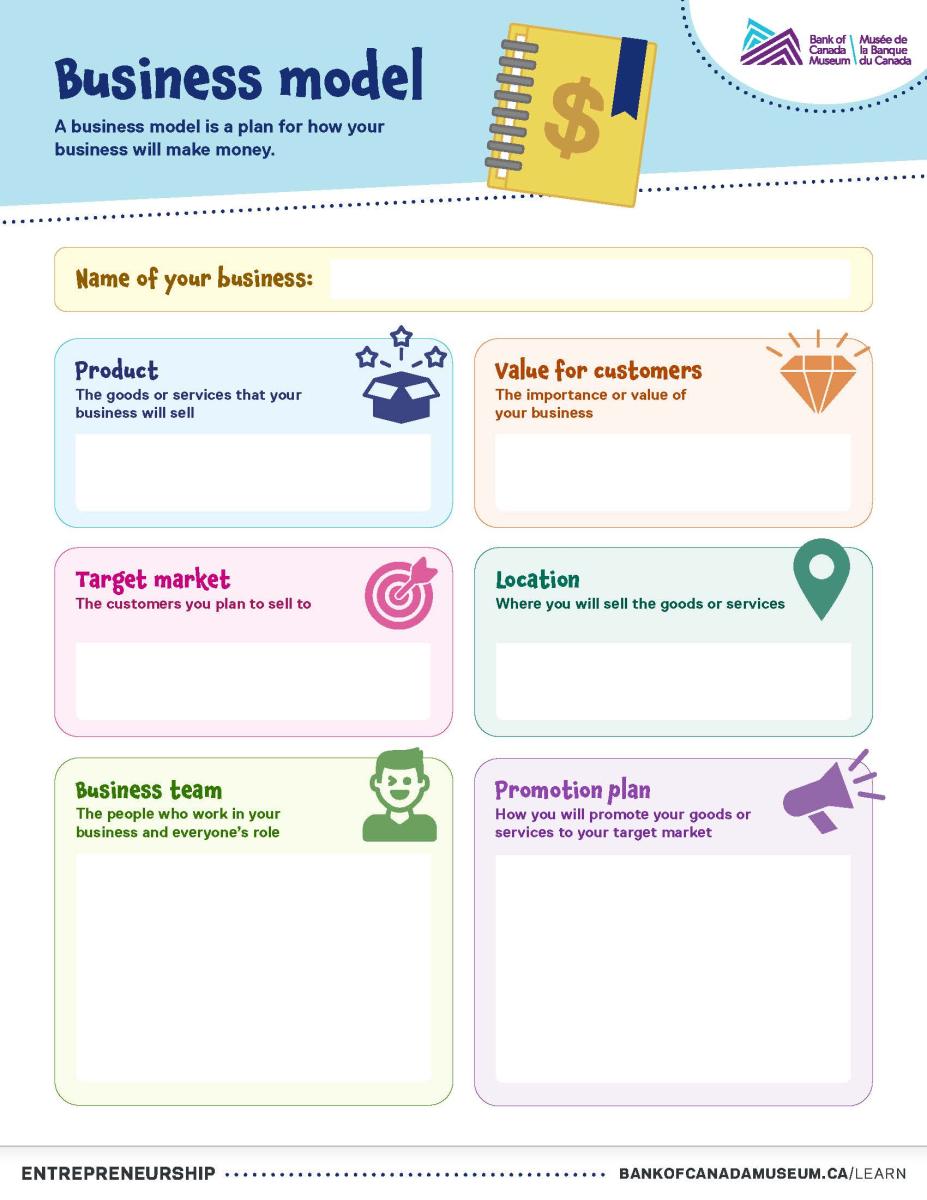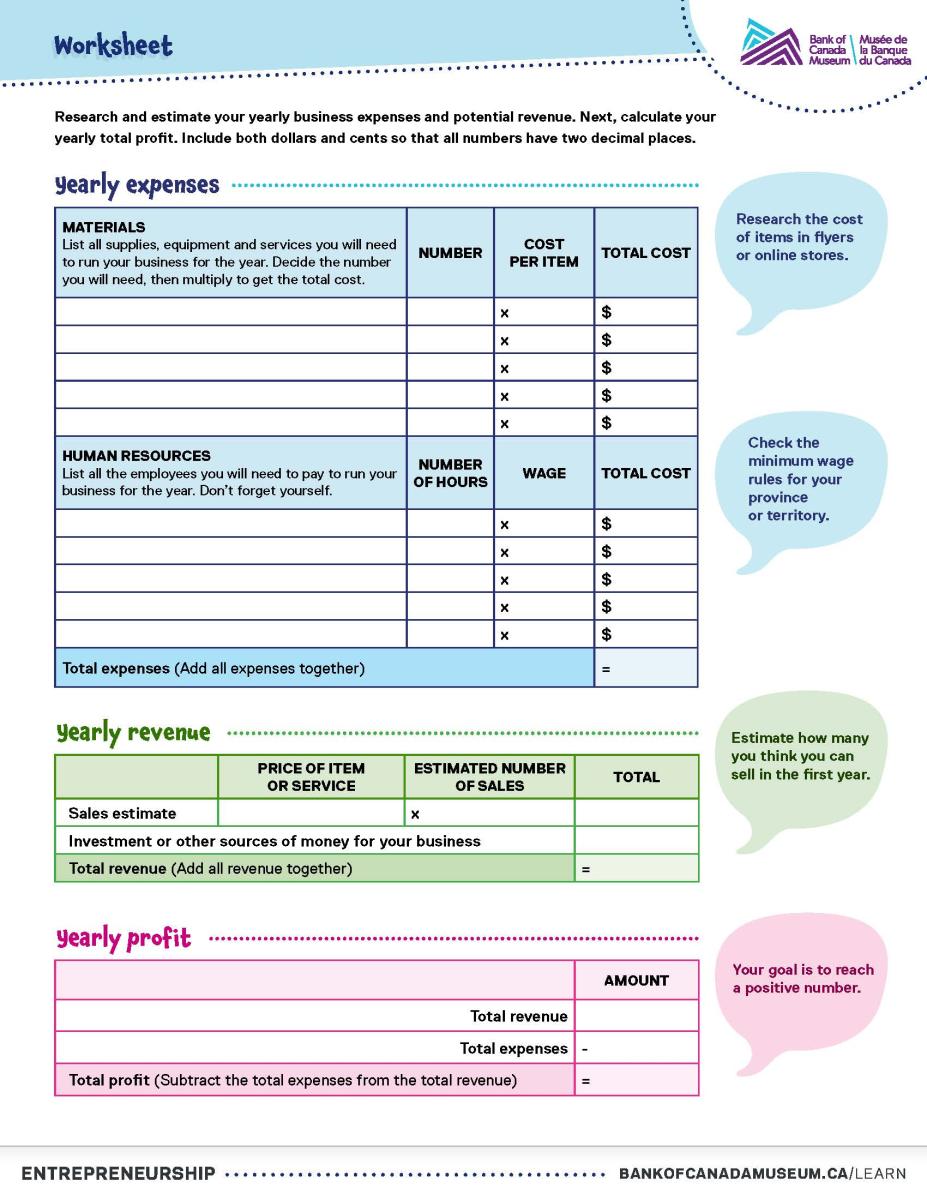
Turn your students into young entrepreneurs as they explore business basics, budgeting and marketing. Pitching their own creative ideas is a fun way to build real-world skills and confidence.
Overview
Big idea
Entrepreneurs play an important role in stimulating the economy. Anyone can be an entrepreneur—even young people.
Total time
175 minutes, 2 to 3 classes including a final class for presentations. The activities are best delivered in the order they appear.
Grade level
Grades 5 to 7; Elementary Cycle 3 to Secondary 1
Subject areas
English language arts
- vocabulary development
- self- and peer-editing
- communicating with a specific audience and persuasive writing
- oral presentation and interviewing skills
Math
- addition and subtraction of numbers with decimals
- math using money
Financial literacy
- entrepreneurship
- creating a business model
Learning objectives
Students will:
- define key business terms
- write a business model and organize writing into a clear structure for a specific audience
- collaborate with peers to select ideas, write and provide constructive feedback
- edit, proofread, peer-review and revise written texts
- estimate business expenses and revenue to two decimal places, then add and subtract amounts to calculate the total projected profits
- write an elevator pitch, understanding the topic, purpose and audience
- explain ideas and opinions with supporting details and respond to others’ questions and ideas
- reflect critically on a variety of oral presentations and evaluate each speaker’s ideas
Materials
Classroom supplies and technology
- printer and paper
- pens or pencils and erasers
- writing paper
- projector or display screen hooked up to a computer
- internet connectivity for the lesson’s video links
- internet-connected devices such as tablets or laptops (optional)
- blank recipe cards, sticky notes, or card stock or paper in palm-sized pieces
- website for elevator pitch videos
- tape or rope long enough to divide a classroom in two (optional)
Worksheets
- Download the worksheet and template below.
- Print these resources. To save on paper printing, you can digitally distribute these resources. All of these PDFs are fillable for ease of use on a personal device, if available.
- Activity 2: “My personal business dictionary” (one copy per student, folded and stapled into a booklet)
- Activity 3: “Business model” (one copy per student)
Activity 1: You can be an entrepreneur
Students learn how kids just like them are becoming entrepreneurs. What does it take to be successful?
Time
10 minutes
1.1 Video
As a class, watch the Bank of Canada Museum’s video “Meet Mya Beaudry, a young entrepreneur.”
Meet Mya Beaudry, an entrepreneur and founder of Kokom Scrunchies. Check out her story about creating her own business. This video was produced for the Museum’s exhibition Money in 10 Questions: Kids Edition.
1.2 Discussion
Follow up the video by asking the students a few questions:
- What were Mya’s four pieces of advice to kids starting their own business?
- Where did Mya sell her goods?
- Why do you think this was effective?
- Why did Mya start making this specific item?
- What does that do for the community?
- What does Mya do with her profits?
- What kinds of costs do you think Mya has for this business?
- Who does Mya collaborate with for her business? How and why?
Activity 2: What is a business?
Students learn key business terms and brainstorm strategies for business success.
Time
30 minutes
2.1 Personal business dictionary
Hand each student a copy of “My personal business dictionary” or ask them to open it on a device. Write or display the following key business terms and their definitions on a whiteboard or screen. Have students write these definitions into their dictionaries, adding their own examples and pictures for each.


This template can be cut or folded to create a booklet. Students will compile key terms in their business dictionary for future use.
- Goods are things people can buy or trade.
- Services are jobs people do for others.
- A business sells goods or services to make money.
- An entrepreneur is someone who starts or owns a business.
- A consumer is someone who buys and uses goods or services.
- A target market is the group of people you want to sell your goods or services to.
- Resources are things you need to run your business, like workers, supplies and materials.
- Expenses are things you have to pay for to run your business, like wages, taxes and electricity.
- Revenue is the money your business makes from selling goods or services.
- Profit is the money left after you subtract expense from revenue.
2.2 Discussion
Ask students to break into pairs and brainstorm with their partner 10 of the most recent businesses they or their families have purchased goods or services from. Students should record their lists in their workbooks or devices. Once they have completed their list, ask the students to share some of the businesses on their lists.
Next, ask a few students to share which businesses on their list are local. Then have students circle all the local businesses on their own lists.
Use their examples to discuss the following:- What are the differences between local and non-local businesses?
- Is it always easy to tell what is a local business (e.g., a local store that’s part of a national or international business)?
Ask students if there are examples on their lists of organizations that provide goods or services to the community but that are not businesses (e.g., a charity or government department)?
Some organizations operate as businesses but offer goods and services typically provided by a charity or government department.
Social enterprises are money-making organizations that operate to make a social impact. Many thrift stores operate in this way. A portion of their business earnings go toward supporting a particular cause. For more on social enterprises, see Innovation, Science and Economic Development Canada’s site “ Social enterprises in Canada.”
Tell your students that anyone can create a business but that not all businesses are successful. Businesses usually consider themselves successful if they’ve met their goals and made a profit. Have students think about the businesses on their lists—the ones they or their families have spent money at recently. Why do they like those businesses? Brainstorm some ideas on the board. Examples might be that a business:
- Meets a need
- Is the only business around providing a particular good or service
- Is nearby or easy to access
- Has high-quality goods or services
- Carries specific brand names
- Provides exceptional customer service
- Has a comfortable environment
- Has low prices
Activity 3: Business models
Students learn to write a business model for a target audience using a business model template and persuasive writing skills. Students also practise proofreading, reviewing peers’ writing and giving constructive feedback.
Time
60 to 75 minutes, or do part as a take home activity.
3.1 Case study
Explain to students that being an entrepreneur has risks. Businesses can lose money or even fail. To make sure your business will be successful, it is important to start with a plan. In business, this is called a business model. A business model is a plan that outlines the most important information for how your business will make money.
Instruct students to add this definition to their personal business dictionaries. Display the “Business model” worksheet for the class. Then, using Kokom Scrunchies from the video as a case study, go through each heading of the worksheet with the class and discuss how students would fill it out for that business.


Students will complete each section of the business model for their own business idea.
3.2 Group work
Tell the students that working with others is a key entrepreneurial skill. Even if someone owns a business alone, they will still need to work with customers and partners in the business community.
Divide students into groups of four and give each group two copies of the “Business model worksheet” printed or one copy digitally.
Ask each group to decide on an idea for a business. If they’re having trouble coming up with one, suggest that they think of:
- activities they like to do (such as walking dogs)
- activities they are good at (such as beading)
- problems they think need to be solved (such as helping seniors who need their walkways shovelled)
Remind students that their business idea should be realistic. For example, they can not base it on things such as technology that has not yet been invented. Their idea could include something that would involve learning a new skill. When Mya started Kokom Scrunchies, she had to learn how to sew scrunchies first. But it should be something they themselves could do in a reasonable amount of time.
Groups will draft answers to the sections in the “Business model” worksheet before filling out the worksheet itself. Remind students to:
- organize their writing into a clear structure for a specific audience, such as possible investors
- refer to their personal business dictionaries if they need help understanding what the sections mean
- follow the rules for minimum wages in their province when filling out how much they will be paying their employees (see the “Current and Forthcoming General Minimum Wage Rates for Canada” in Service Canada’s “Minimum Wage Databases”)
- calculate expenses by adding the costs of materials and people needed to make or deliver the product or service (human resources)
- calculate revenue by estimating how many of the product or service they will sell
- try to find a balance between expenses and revenue that results in a profit, or a positive number after you subtract expenses from revenue
Then, working together, each group will complete two identical copies of the worksheet if printed. If working digitally, they will only need one.
Remind students that entrepreneurs may be judged poorly by investors if they have math or language errors in their business models. Each person in the group should look over the two copies of their final draft to proofread for any errors. They should check that:
- their spelling, grammar and punctuation are correct
- their business model has a clear focus
- their math is accurate
- they have written with their target audience in mind
3.3 Peer review
Explain to students that successful entrepreneurs use mentors they trust to guide them in making business decisions. In her video, Mya Beaudry talked about the importance of a support system. Having a strong network is critical for businesses, and the ability to accept feedback and take guidance from trusted advisors will help a business grow more quickly. Entrepreneurs often have to provide constructive feedback to employees, partners and other business owners as well.
Tell students they will practise giving this kind of constructive feedback. They will also practise their analytical, math and literacy skills as they:
- review the potential of other businesses
- check that their peers’ yearly expenses, revenue and profit make sense
- proofread their peers’ work
Collect the final drafts of the business models and distribute each group’s models to two different groups for review. If the class is working with digital copies, have them send you a copy so you can distribute it. Keep track of which group is reviewing which models. Each group should end up with two different business models to review and is responsible for:
- giving feedback on the business ideas and concepts
- checking the math
- checking language conventions
They can record feedback on a separate sheet of paper and attach it to the original business model or add notes to the digital copy.
Return the two sets of feedback on each business model to the original groups. Each group will then use the feedback to refine their final draft to submit.
Activity 4: Elevator pitches
Students practise distilling ideas into short, concise, persuasive presentations [in the form/using the art] of an elevator pitch.
Time
30 minutes
4.1 Videos
Explain to students that an elevator pitch is a very brief talk meant to generate interest in a business idea and convince someone to support that business. The name refers to the span of time of an elevator ride when you might be able to get a few moments of someone’s time if they aren’t busy. A good elevator pitch should clearly explain the main idea of the business, its goods or services, and why the business is valuable to customers and investors. The pitch should also make a connection to the listener.
Tell students to add this definition to their personal business dictionaries. Have the students watch some videos of elevator pitches made by businesses, for example from the CBC show Dragon’s Den. (Note that these pitches are longer than a standard elevator pitch. On the show’s home page find videos under the tab “Pitches.”) Students should take notes on what they thought did and didn’t work in the pitches.
4.2 Group work
Explain that most entrepreneurs need some form of start-up money for their new business or extra money when they need to expand. They may use their own money; get a loan from their family or a bank; ask for contributions from a large group of people, known as crowdsourcing; or look for investors who will provide money in exchange for a certain percentage of the business. Mya started Kokom Scrunchies with $15, and she invests much of her profit back into the company so it can continue to grow.
Tell students that if they don’t have their own money to use for their business idea, they will need to use their elevator pitch to convince others to invest or lend that money. They should try to convince others their business will have value and be able to make a profit.
Investors are individuals or organizations who give money to a business with the expectation that they will make a profit or own part of the business in return. Instruct students to add this definition to their dictionaries.
Students can add crowdsourcing and investors to their personal business dictionary.
Activity 5: Pitch your plan
Students play the roles of entrepreneurs and investors to practise oral presentation and interviewing skills as well as listening comprehension.
Time
Approximately 40 minutes (depending on the number of groups)
5.1 The Pitch
In their small groups, students should write an elevator pitch of up to five minutes to present their business idea to potential investors. Tell them to keep in mind their business topic, the purpose of their pitch and their target audience as they write. The pitches should include how much money they need and what they would be able to do if they received it. To help them draft their pitches, they can use their business model worksheets and the notes from watching the video examples.
Groups should also write down some questions they might ask an entrepreneur pitching a business idea. These questions need to probe the idea and get more information about the business opportunity.
Each group then presents their elevator pitch to the class in a game called “The pitch.”
For the first round of the game, assign one group to be the entrepreneurs and another group to be the investors. (The investor group should not have done a peer review of the business being pitched in that round). The entrepreneur group gives their elevator pitch, and then the investors ask their questions. Set a cut-off time of about five minutes for questions. The entrepreneurs should respond thoughtfully to the investors’ questions and ideas.
Repeat the game with further rounds of entrepreneurs and investors. Students should listen carefully and consider each business idea. When all the pitches have been given, tell the students they each have $5,000 to invest. They can decide which businesses they would like to invest in, either investing all $5,000 in one business or dividing it among more than one business.
Hand out sticky notes, recipe cards, or small pieces of card stock or paper. Ask students to write down which businesses they would like to invest in and how much they are willing to invest. Next, collect the investment offers and let each group know what offers they have received. If you’d like, you can debrief this with the whole class and highlight some aspects of students’ presentations that were particularly effective.
Conclusion
Using movement, review key terms and concepts as a wrap-up activity.
Time
5 minutes
Review: True or false line activity
Have students move their desks or tables to the sides of the classroom if space is needed. Create a line in the centre of the room using rope, tape or whatever you have handy. (Caution students about any tripping hazards.)
Ask students to stand directly on the line. Explain that one side of the line is true, the other false, and that students should return to this line after each question. Tell them to move to the side of the room that reflects their answer to each of the following statements:
- An elevator pitch is a very detailed proposal giving all the information about a business.
- False—elevator pitches are short and concise.
- A business is any organization that provides a good or service to the community.
- False—many different types of organizations provide goods and services to the community, but businesses provide goods and services to consumers for profit.
- Profit is all the money earned by selling goods or services.
- False—this is revenue.
- Expenses are all the costs that businesses have to pay for.
- True.
- Successful businesses [do/make] it all on their own.
- False—successful businesses rely on networks, partnerships, mentors and a support system.
- To be a good entrepreneur, just start by selling something.
- False—to be a good entrepreneur, start by making a business model.
- A business is an organization that provides goods or services to consumers for profit.
- True.
- Profit is the total amount of money a business has left after expenses.
- True.
- Mya Beaudry recommends starting small.
- True.
- Kids can’t be entrepreneurs.
- False—Mya Beaudry started a very successful business.
Key takeaways
- Anyone can be an entrepreneur, even kids. Entrepreneurship requires understanding key business terms and being able to create a good business model.
- All entrepreneurs need a support network. For kids, this is often their families and friends.
- Being able to write and deliver an elevator pitch is an important part of promoting your business, yourself and your ideas.
Extensions
- Invite a local entrepreneur or business owner to listen to the elevator pitches and give feedback. Have students pay attention to the kinds of suggestions made and how that person gives their feedback.
- Have students write an elevator pitch about themselves for potential employers or business clients.
- For more on the kinds of industries that businesses in Canada belong to, check out our lesson “Connecting Canadian Industries.”
- Add further key terms to the personal business dictionaries from other lessons. Or use the dictionaries to build vocabulary and literacy or for additional language-learning activities, such as:
- including a certain number of terms in an article or blog
- creating a list of synonyms for the terms
- generating spelling lists
- creating and playing fill-in-the-blank word games
- The Bank of Canada regularly asks business leaders for their opinions on what’s happening in the economy and publishes the findings in the Business Outlook Survey. Have students interview three local business owners about what trends in the economy are affecting businesses in their region. Students then create a report about what they learned.
- For more advanced students, explore the concepts of comparative advantage, opportunity costs and specialization between businesses and countries in our lesson “Trading up: how countries benefit from freer trade .”
We want to hear from you
Comment or suggestion? Fill out this form.
Questions? Send us an email.
